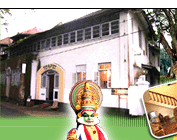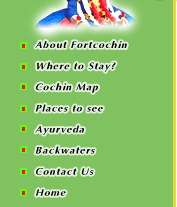



|
Chinese Fishing Nets The
huge, elegant Chinese Fishing nets that line the northern shore
of Fort Cochin add grace to an already characterful waterside view,
and are probably the single most familiar photographic image of Kerala.
Traders from the court of Kublai Khan are said to have introduced
them to the Malabar region. Known in Malayalam as cheenavala, they
can also be seen throughout the backwaters further south. The nets,
which are suspended from arced poles and operated by levers and
weights, require at least four men to control. You can buy fresh
fish from the tiny market here and have it grilled on the spot at
one of the ramshackle stalls. St.Francis Church Walking
on from the Chinese fishing nets brings you to a typically English
village green. In one corner stands the church of St.Francis, the
first European church in India. Originally built in wood and named
Santo Antonio, it was probably associated with Franciscan friars
from Under the Dutch, the church was renovated and became Protestant in 1663, then Anglican with the advent of the British in 1795 and since 1949 has been attached to the Church of South India. Inside, various tombstone inscriptions have been placed in the walls, the earliest of which is from 1562. One hangover from British days is the continued use of punkhas, large swinging cloth fans on frames suspended above the congregation; these are operated by people sitting outside pulling on cords. The interior of the twentieth-century Santa Cruz Cathedral, south of St Francis church, will delight fans of the colorful-verging on the downright Gaudy-Indo-Romano-Rococo school of decoration.
|